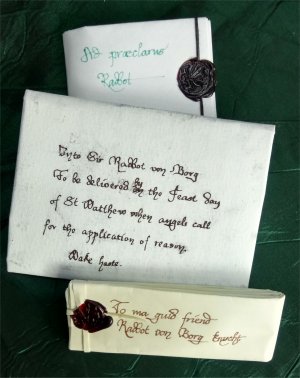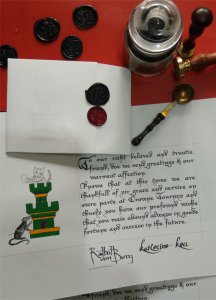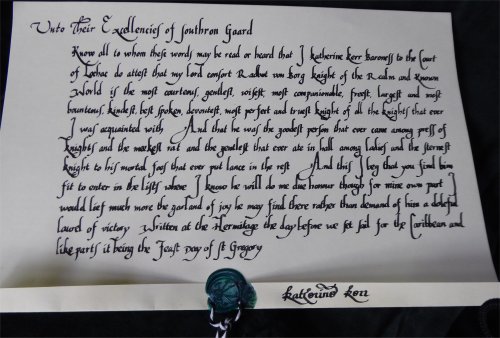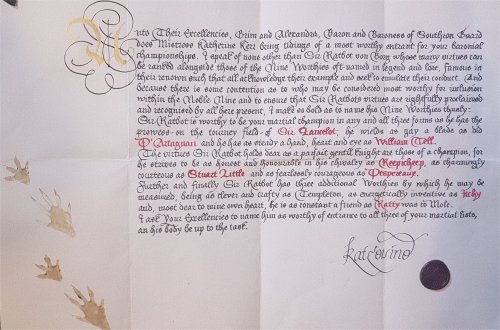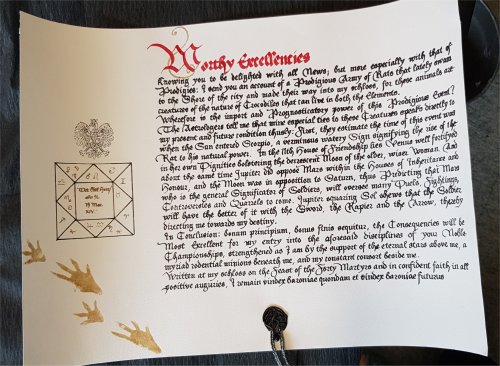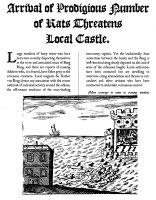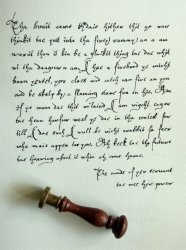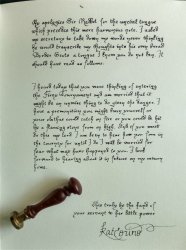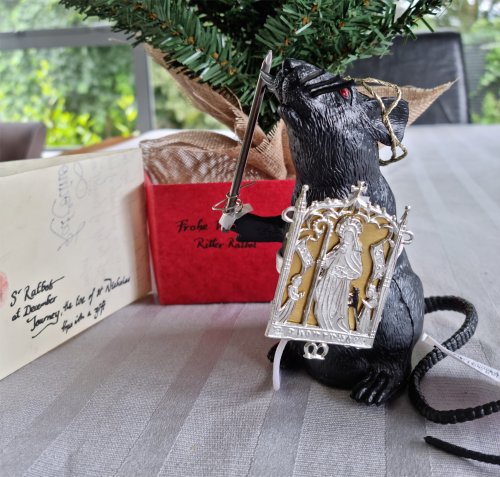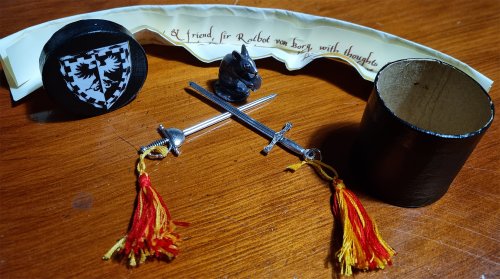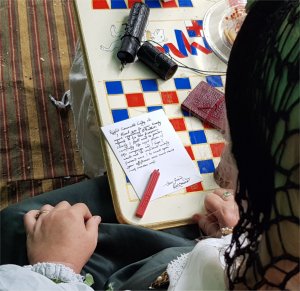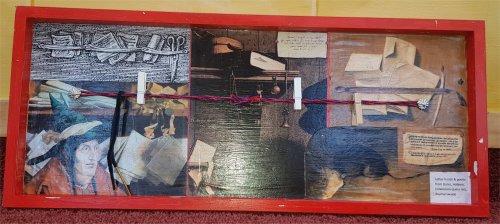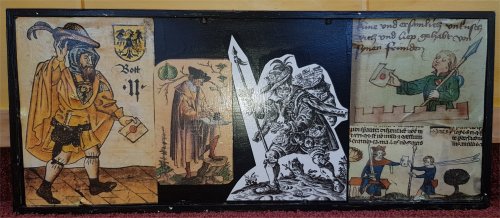 |
|
Consort Correspondence
Bond of Manrent and Letters of Intent for Crown Printing and Manuscript Material G8/15: I'll note you in my book of memory : Pleaseth yir goode lordshippWhile undertaking a long journey to northern parts, I despatched a number of letters to my lord-consort Sir Radbot von Borg assuring him that we continued to be safe and expressing interest in his welfare, as a good consort should. I had felt slightly guilty at abandoning Sir Radbot after we two had contracted as consorts; I have missed more of his tourneys than I have been present to take his salutes. So these letters are intended to assure him I take my responsibilities seriously.My lord-husband and I travel a good deal, so it was inevitable that there would be occasions when I missed taking my lord-consort's salutes. These occasions have provided good opportunities to practice my scribal skills, and have since developed into a very rich area of SCA persona development that continues to entertain and challenge. Format and StylesWhen writing, I use a number of hands:
The main aim is that they should, in general, be readable to the average eye. I want these letters to be read (mostly). I usually typeset any manuscript electronically and use a lightboard to write over the laid-out text, though I'm getting better at freehanding, which is the eventual aim. Matching nib size to the correct point in the chosen font helps, as does using better-quality paper or parchmentine (I have lots of cheap watercolour pads which bleed excessively). When writing in the Scottish hand, I tend to use Scottish/Elizabethan usage in terms of spelling, long s, vocab and the like. The humanist hand is more modern and clear in its use of language. The opening salutations and the placement of the closing signatures all had subtle meanings, which changed over time as did other styles and usage -- the use of Right worshipful in the wrong context could be seen as snide; writing "Dear so-and-so" was, at one stage, used only by royalty to women of rank; knights would sign off to other knights as "faithful lover" with no carnality implied; lovers would use the formal "you" when writing about business and drop into the more-intimate "thou" and "thee" when covering personal matters. I know that most of this is highly arcane knowledge, but it amuses me to apply such usage, even if I'm the only one who knows the sub-text! If this kind of thing appeals, I can thoroughly recommend Sarah Williams' thesis (PDF) English Vernacular Letters c.1400-c.1600: Language, Literacy and Culture; University of New York 2001. The letters may be left open (as when treated as a letter patent, whether to authorities or for general readership); or sealed. In the latter case I have a range of seals, with my double-initial KK being used for my signed correspondence, and others used for third-party missives (eg an R for Radbot, fleur-de-lys, cross fleury etc). I have a number of jars of sealing wax pellets -- bear in mind, if you get the stuff designed for mailing it's great in that it flexes, rather than breaks, but that means you can't readily use it on a letter you actually want opened, without having to shred the paper. If I need to use this wax on something to be opened. I make up seals on a silicone baking sheet and then glue-stick them on so they will peel off cooperatively. The letters are generally folded in some form of period letter locking, involving various ways of folding, sewing or using paper strips to secure the pages of the letter from unauthorised readers. There's something very tactile about this which really makes the correspodence somehow feel more real. Thank You Notes
For May Crown ASLIV, I made up half-a-dozen thank-you notes in advance, featuring our cat and rat tower marginalia, hand-painted. These were signed by both of us, folded and sealed. On the outside, I addressed them to those who had been kind enough to help us out at the tournament, and had them delivered the next morning. I gave other helpers the roses I was given as a finalist consort (I kept one of the white ones for remembrance, and its dried petals ended up as a keepsake in my breverl amulet). If you'd like to make thank-you notes of your own, check out the Letter-Writing Cheat Sheets, a PDF which covers writing, laying out and sealing a period-style thank you note. Baronial Anniversary Champion Letters of IntentSouthron Gaard's Baronial Anniversary is typically held some time near our baronial founding date of March 23rd, and involves Baronial Championships in heavy, rapier, archery and arts and sciences. To enter the martial championships, one has to supply a Letter of Intent to the Baron and Baroness. When I became Sir Ratbot's consort, I took on this duty, and have had quite a bit of fun with it... AS54: The Arthurian MotifBaronial Anniversary in 2020 was post-poned three months due to COVID. I occupied the lockdown time with the many letters and other documents recounting the Fateful Trip: the Caribbean Voyage from the Baskin-Kerr Archives. As part of my travel preparations I had scribed a letter of recommendation, in a nice readable humanist hand, to be delivered to Their Excellencies at the presentation of the Letters of Intent which opens the Champion's Tourney. As it happened, cancellations because of COVID meant that I was there after all and got to read the letter in Opening Court. My letter asked Their Excellencies to permit Sir Radbot to fight, citing the knight's many virtues (lifted from Paston Letter 102, pg 210):
It went on to cite Sir Ector's eulogy for Sir Lancelet, from Morte d'Arthur (ironic as neither of us are that impressed with Lancelot), but the words suited the occasion: And then closed with a sincere wish: As the letter itself mentioned my now-deferred imminent departure for the Carib Seas, I updated it verbally with words along the lines of how the world had changed since penning the letter, but that Sir Radbot had not changed, for he is as the stars of an evening sky -- a constant, shining knight. I figured if that wouldn't get him in the lists, nothing would! (And yes, he became Baronial Champion on the day.) AS55: The Nine WorthiesThis time round, I used the concept of the Nine Worthies as the model for the Baronial Championship letter. These are nine historical, biblical, and legendary heroes who personify the ideals of chivalry. They came on the scene in the early 14th century and remained a popular concept throughout period, exemplified in many different types of artwork and literature. The most common line-up were three pagans (Hector, Alexander the Great and Julius Caesar), three Jews (Joshua, David and Judas Maccabeus), and three Christians (King Arthur, Charlemagne and Godfrey of Bouillon). But more personalised or nationalistic lists were not uncommon. There are female counterparts, and maybe one day I'll find a good reason to reference them in particular.
For Sir Ratbot, nothing but a special set of Worthies would suffice; to wit: Unto Their Excellencies, Grim and Alexandra, Baron and Baroness of Southron Gaard does Mistress Katherine Kerr bring tidings of a most worthy entrant for your baronial championships. I speak of none other than Sir Ratbot von Borg whose many virtues can be ranked alongside those of the Nine Worthies oft named in legend and lore, famous in their renown such that all acknowledge their example and seek to emulate their conduct. And because there is some contention as to who may be considered most worthy for inclusion within the Noble Nine and to ensure that Sir Ratbots virtues are rightfully proclaimed and recognised by all here present, I make so bold as to name his Nine Worthies thusly: You can see that a rodential minion has made his mark on this letter. That is, I carved a stamp of rat tracks and use it with some interesting pomengranate ink (thanks Josh!) which produces quite a shiny tactile set of pawprints. The rodential Worthies are mostly well-known enough for people to catch on to the references before the last unmistakeable citation. All joking aside, I believe that those rodential Worthies are indeed worthy to be associated with Sir Ratbot's avowed knightly virtues of honesty, courage, prowess and courtesy. This is my favourite Letter of Intent. AS56: Prodigious RatsThe Champion's Letter for AS56 (2022) was based on a news report from 1670 regarding a prodigius rat infestation in Rotterdam, accompanied by a period-style horoscope cast for the day in question with its interpretation. It read as follows:
Worthy Excellencies
Arrival of Prodigious Number of Rats Threatens Local Castle. There is also the story of the 10th-century Archbishop of Mentz, Hatto, who burned a barn full of peasants to prevent them eating his grain during a famine. Some 10,000 rats marched upon his palace and, when he took refuge in a tower in the middle of the Rhine, they swam out there and ate him. It makes a nice change to see rats as the instruments of divine justice instead of the bad guys. Lord Simon of Cluain inspired further silliness and there were a range of different rat-based news items scattered around the event, from Banksy-inspired artwork calling on rats of the world to unite to multi-lingual declations that there can only be one cheese-master. Towards the end of the event, a final news-sheet was distributed: Victory Declared over Plague of Rodents Tourney LettersLetter, primusAfter May Crown ASLIV, I had a sojourn overseas and would be missing three of the Baronial monthly tourneys. To ensure I remained a dutiful consort, I prepared three letters, which were given to the Baroness of Southron Gaard for delivery when Sir Radbot made his salute to me. The first letter was written as my lord-husband and I prepared to depart (dated the Eve of St Bartholomew), and was set to be delivered at the September tournament. In lightly period-style spelling and phrasing, it wished Sir Radbot well in his endeavours and quoted from Socrates: "the greatest way to live with honour in this world is to be what we pretend to be." An apt aphorism for an SCA knight! It was penned in green ink, purchased in Venice, and a homage to katherine's associated garb colour. It was letter-locked by sewing linen thread through the pages to hold them together and then sealed in red wax with my KK seal. There are a lot of different examples of how letters were secured in period -- over 70 at last count and rising -- and it does make a letter feel more finished and real. G8: Letter, secundus: Lang may yer lum reek!I have some languages: the Scots of my country (though little used here in the Laurel Kingdoms, so mostly forgotten); the English of our near neighbour and the close dialects used within the land of Lochac; and a smattering of the Latin and Italian I learned when a young girl living in the Venice of my birth. One of my long-held SCA disappointments is how difficult I find it to do a convincing accent, so katherine has never sounded particularly Scottish, but I am becoming more familiar with Scots usage in written form. In this letter, the first page of the bifolium (the folded paper typically used for correspondence) was written in a tight secretary hand using as much Border and Lowland Scots terms and forms as I could muster, using an English-Scots translator supplemented with various word lists. By the time I was finished, it was pleasingly well-nigh incomprehensible....It thus covered entry 8 of the Gubbins Challenge for the use of vernacular language. This Challenge provided impetus to take a look at Scottish terms, vocabulary and oaths; a surprising number of which were reasonably familiar to me! The second letter was set for delivery at the Fiery Nights Tourney -- the Feast Day of St Matthew whose angel stands for the application of reason. The latter was pertinent as the letter expressed concerns for Sir Radbot's safety in such a dangerous environment where he "may be burned or [his] clothes catch fire or flaming stones rain down upon [him] from on high" or as the Scots version ran: "I hae a firebrod ye micht burn yersel, your claes cuid catch oan fire an you cuid be skelp by a flaming stane fra on hie." The second page had katherine's apologies for "the uncivil tongue which precedes this more harmonius note" as she went on to explain that she had asked her secretary to take down her words "never thinking he would transcribe my thoughts into his own broad Border Scots, a tongue I know you do not ken". She then provided a clear English translation of the original text, albeit somewhat gentler in tone than the Border Scots. Thus the secretary's transcription started: Tha bruit came th’daie hither thit ye war thinkit tae put inta tha firey rammy an a am worriit thon it kin be a glaikit thing tae dae whit wi tha danger n aa. Or as katherine put it: I heard today that you were thinking of entering the Firey Tournament and am worried that it might be an unwise (Scots glaikit = stupid) thing to do given the danger.
The address included the instruction "make haste" -- this was not an uncommon phrase, sometimes repeated again and again, on letters with a time-critical aspect. Cecil and Burghley were known to use this inscription when about Queen Elizabeth's business. The letter was locked using a tucked-in format and a seal, based on the tucked triangle form used by Desiderius Erasmus in 1517. I am told Sir Radbot was called up in opening court to receive the missive and spent some time with Sir Sebastian trying to puzzle out the Scots (much easier to do when you try reading it aloud!). It apparently took them some time to notice the second page in clear text.... Given that I ayewis gie it laldy, I now have a list of interesting words and phrases I may throw into the conversation and see how they go. References Letter, tertiusThe third letter mentioned that my travelling party was "strugglin oer the mountin passes inta the Switzer landes" (we were due to fly into Geneva on the day of delivery) and that I'd heard Sir Radbot was travelling himself (delivery was set for Spring War in Mordenvale, which he was attending). I gather he bounced up to Her Excellency Ginevra and asked if there was mail for him -- and yes, yes there was. A post-script chatting about buying some materials along the Silk Road referred to a planned project (and I hoped to hit the Chinese fabric markets in Bangkok on my way home). Much of the text and style of these letters has been informed by the family letters of the Pastons and Lord and Lady Lisle, which often mention very practical things like pleas for purchases from the London shops, worries about lost dogs or falcons, and thanks for gifts of bucks or fish. This letter was written in sepia ink; actual squid-derived ink I had bought in Venice. It was letter-locked in a butterfly format close to that used by Mary Queen of Scots in her last letter in 1587, with the addition of a wax seal. This format sees a strip cut from one side of the bifolium which is then woven through and around the folded paper. Letters, Letters and More LettersDear my lord consort Sr Ratbot von Borg do I Katherine send a poor greeting via this missive for I cannot attend upon you this day as my lord husband requires my presence upon the sea roads... As the years ticked over I found many an occasion to write a letter excusing my absence from the monthly baronial tournament due to various pilgrimages of one form or another. It has become my habit to ensure that a letter, often accompanied by a small gift, is presented to my consort at the event. I am very grateful to Mistress Ginevra for her patience in acting as my tourney courier; so far I have missed only one tournament. Sometimes I am privileged to receive confirmation that Sir Ratbot has the letter in hand. The one pictured below was written for the December AS56 tournament, and contained a Christmas gift of a pilgrim badge of St Gertrude, a Germanic saint associated with rats.
For the June AS57 tournament, I provided a letter and a small bronze Roman rat holding a seed, a popular figure from around the third century AD. When I heard he had won the tournament -- as he tends to do when I am not present -- I sent an electronic missive from the Spanish lands of el Andalusia where the horses are even more polite and graceful than the people. And went on to say: I have been pondering on how well you do in my absence and posit the thought that mayhap there is an opposite law to the inverse square one proffered by the natural philosophers in that the effect grows the further I am from you. If so a journey to the Moon would appear the thing for Crown Tourney... Sir Ratbot responded with an image of the letter and gift as received, along with the two tournament tokens he had won for coming first in heavy combat and the rapier tourney.
When meeting up with my kids in Santorini, I found out Sir Ratbot was attending Yule (June AS57), and would be fighting in a tournament there. So I made haste to send text and instructions to the ever-helpful Ginevra for the production of a letter to cover the event, accompanied by a black feather clearly singed by the Sun: Unto Sir Ratbot von Borg does his far-off consort send her greetings and assurances that she has not abandoned him but keeps him ever in mind. A Postal Service is BornWhile at Canterbury Faire (AS55), I needed some assistance in surprising Sir Radbot with a new table placing - a plate and bowl I had painted with his rat charge and favourite virtues. He wasn't attending the feast so I arranged with the helpful Lady Melisande for her to see that it appeared in his campsite's dining tent. Next morning, much to my delight, the young bun-smith girls detoured from their early morning bun delivery to hand over a small note from Melisande:
Thence followed some negotiations with the urchins regarding the going rate for a return reply. I duly scribed my thanks to the good lady and sent the girls off with some biscuits and chocolate. Never under-estimate the mercantile capabilities of 12-year-olds! Interestingly enough, late-period letters indicate the development of the official post, with letters to and from the continent having sequential endorsements on the outside as they passed through various staging posts, a forerunner of our track-and-trace. Simon Garfield, in To the Letter, Through a Vanishing World, cites a series of endorsements on a letter from Robert Cecil to Sir Francis Darcy in 1601. The letter was sent from London to catch Darcy in Dover, and marked "post hast hast hast for life life life lyfe". It was endorsed as it passed through the royal post stops "for her Maits affayres": from London "this 23 of September at 8 in the morninge"; "Dartfor at 11 in the fornone"; "Rochester at 2 in the afternon". On that occasion the rush was for naught -- the letter was returned to Cecil with a picture of a gallows on the outside! The lead-up to the following Faire saw much in the way of preparation, with me penning a dozen or so letters and prepping suitable deliveries to mark particular occasions at Faire. The Courier ServiceI negotiated the services of a bonded courier, aka scarsella (so-named for the leather bag used to carry the mail), a corrieri or an espresso; in English usage, a messenger, nuncius, or a cursor (that last one is technically most correct as the gallant Zoltan was acting on foot, rather than being a messenger on a horse). The following terms were set based on various contracts and oaths of fealty for messengers from 14-16th century Italian and English documents (leaving out the fine of paying a tun of wine on failure to deliver!). It was read out at Opening Court: Let it be known that the bearer of these credentials is a trusty and well behaved Messenger who should be granted speedy and safe passage to be free to go about the faithful delivery of all such letters, packets, writs, warrants and other documents that he is entrusted with for despatch and be permitted to undertake all other duties whatsoever that appertaineth to the fulfilment of his office. I had negotiated a generous tab at the Mangy Mongol to be utilised by the courier and any assistants; others caught on and arranged their own terms, and letters, invitations, thank you notes and the like started spreading across site. (The best being the "late-night drunken texts" composed by the Gildenwick Mead Appreciation Society.) I made up a mail bag of the type seen in various woodcuts, in material, and partly as a trial run for making a bag for myself one day. Zoltan seemed to have enough business to keep him happy and generously shared the courier Mong tab. I intimated that any attempt to interfere with letter deliveries would incur my displeasure and possibly a plague of rats.... Though as it happened, overnight COVID restrictions meant closing the gates of Faire to the select 100 happy few already on site, leaving Sir Ratbot outwith the walls. So there's a big batch of mail for him awaiting delivery at next year's Faire. Letter RackThere had been suggestions of a postbox competition of some form, so I put together a mailrack based on the letter-filing practices seen in numerous Renaissance paintings where red strips of cord or leather are used to hold items in place against a wall or shelf. The front was decorated with a montage of various paintings depicting such practices (including a sweet image of a rat gnawing on a dropped item of correspondence); the back with images of scarsellas, couriers et al going about their business.
It proved very handy to be able to clip a letter to the rack in the confident knowledge that my courier would check on it and see it delivered. And equally delightful to wander down to the Green Man and see some new mail on the board. Further plans are afoot.
| |||||||||||||||||||||||||||||||||||||||||||||||||||||||||||||||
